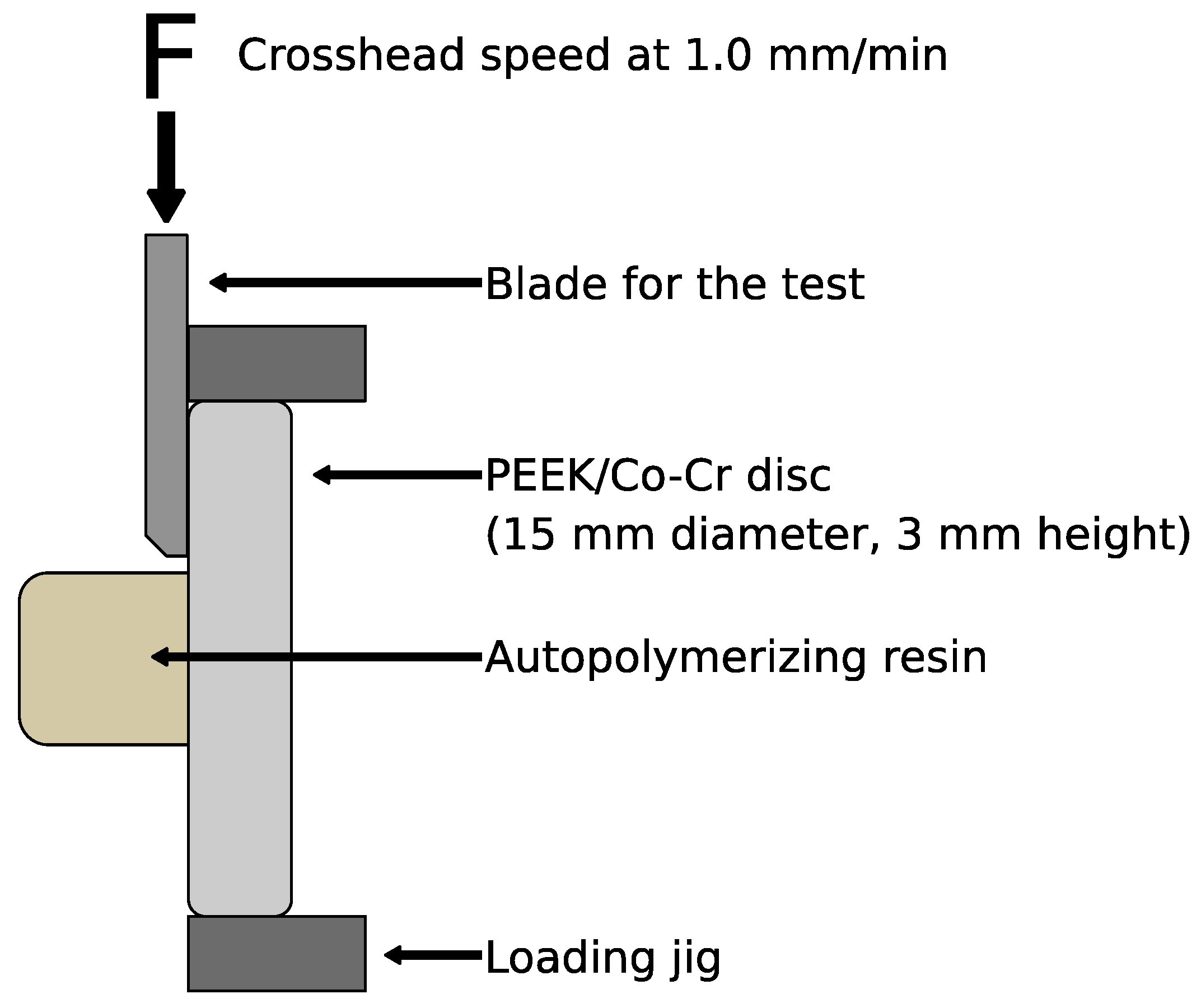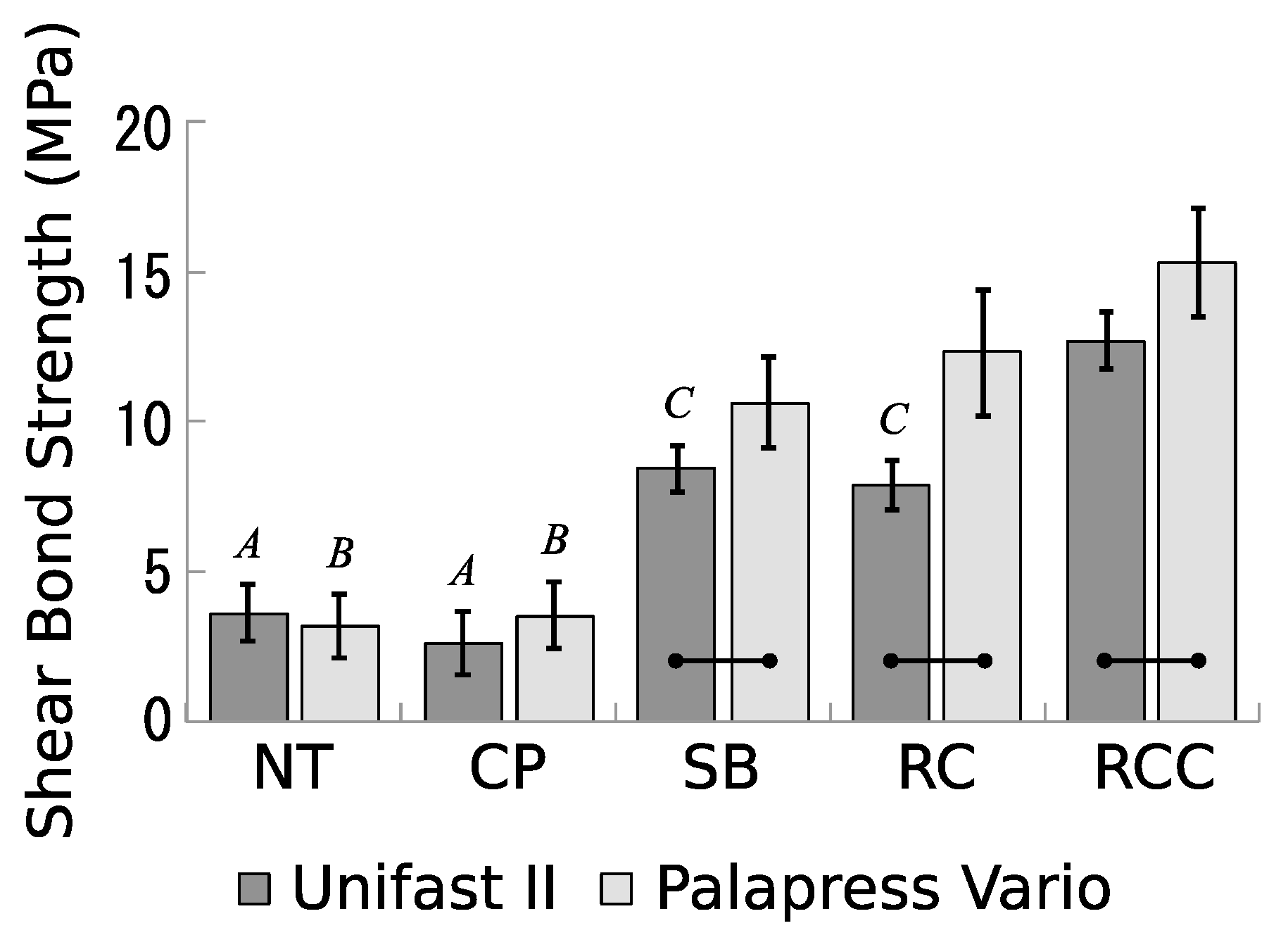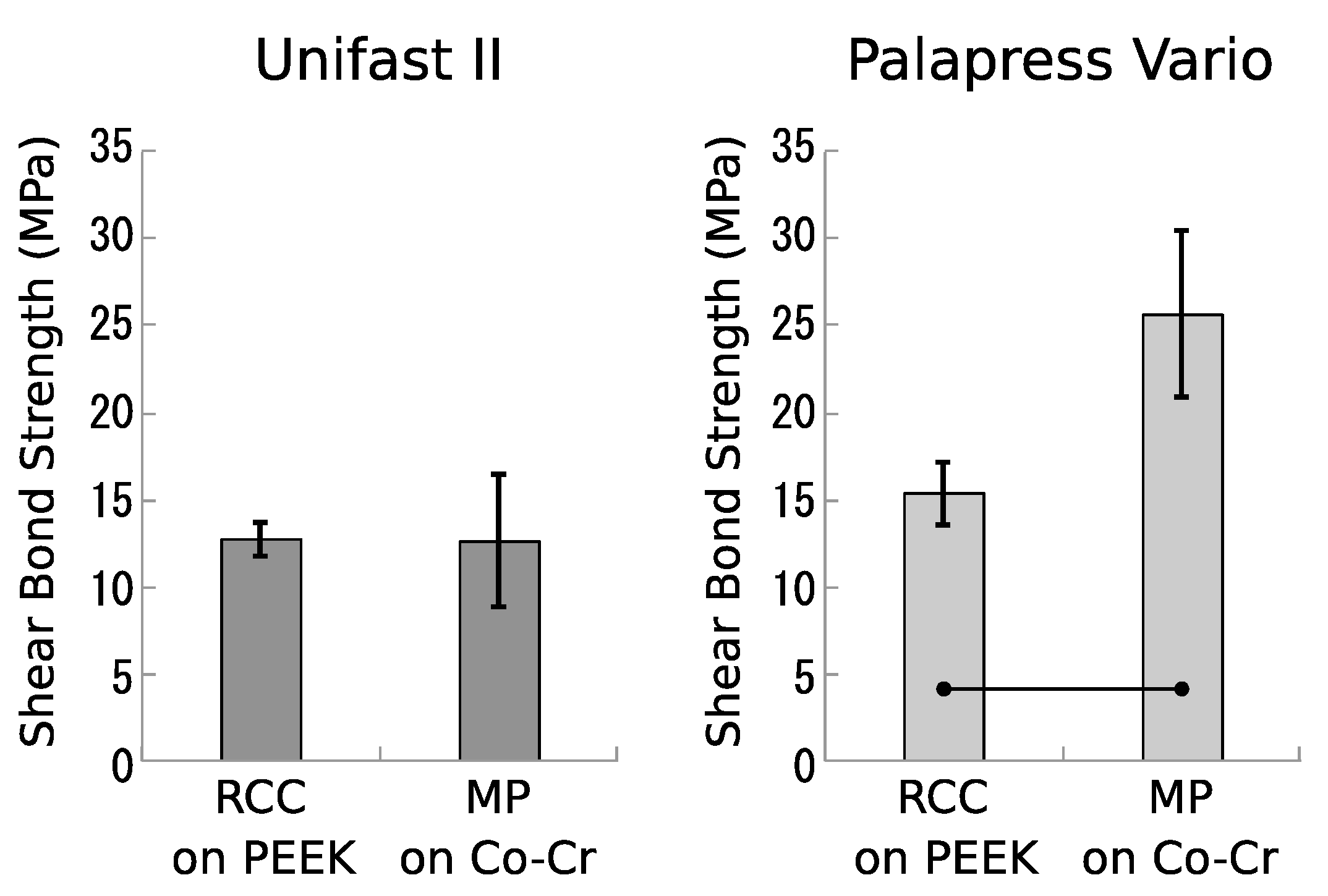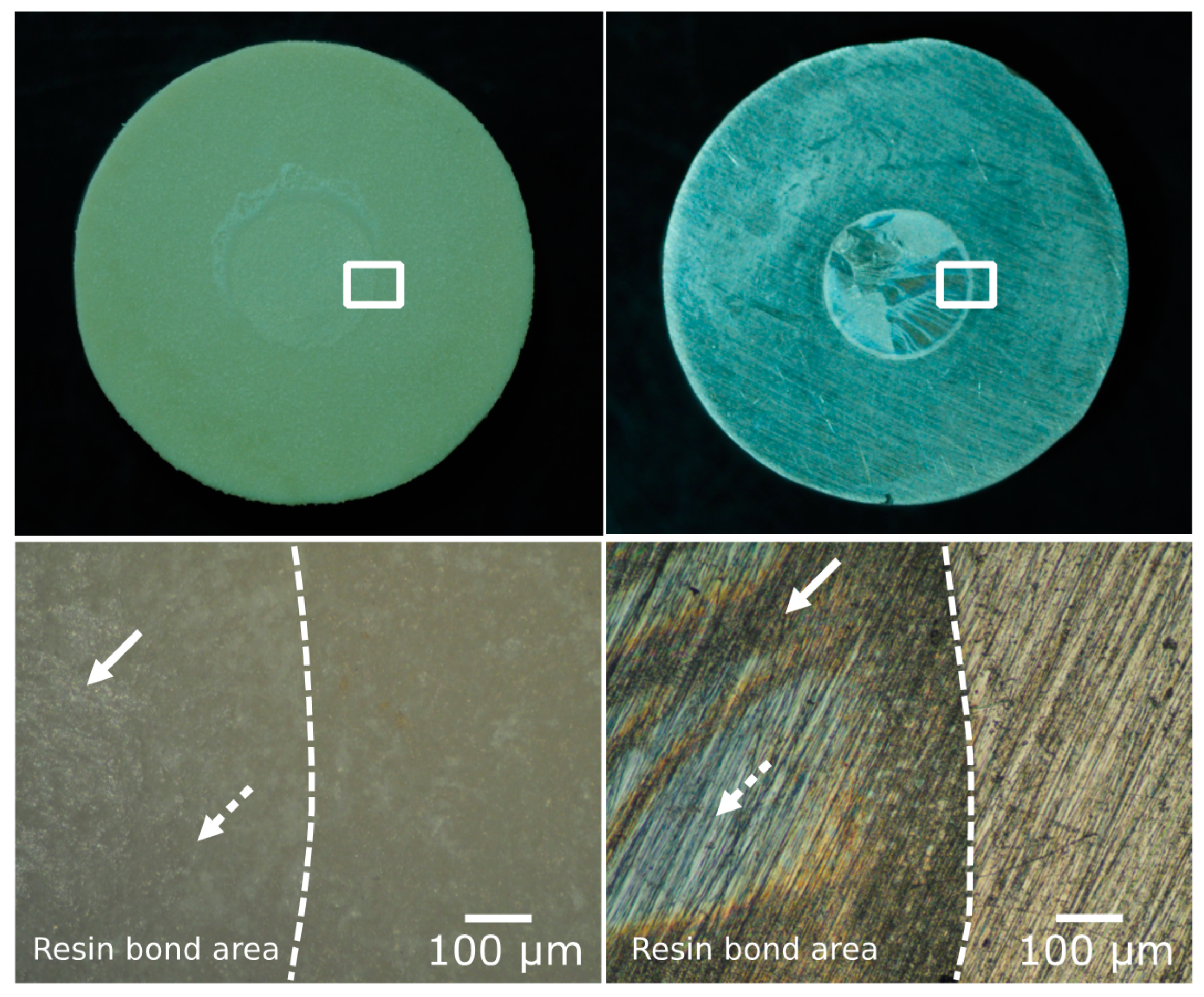Effect of Surface Treatments on Shear Bond Strength of Polyetheretherketone to Autopolymerizing Resin
Abstract
1. Introduction
2. Materials and Methods
2.1. Materials and Specimen Preparation
2.2. Surface Treatments
- NT: No treatment.
- CP: Priming with the ceramic primer by using a dental microbrush and air-drying.
- SB: Sandblasting with 50 μm Al2O3 under pressure (0.3 MPa) for 10 s at a distance of 10 mm, with a vertical angle between the nozzle and specimen surface. This was followed by cleaning ultrasonically for 10 min in distilled water and air-drying [25].
- RC: Treating with the Rocatec system, which involved sandblasting with 110 μm SiO2-coated Al2O3 under pressure (0.3 MPa) for 13 s at a distance of 10 mm, with a vertical angle between the nozzle and specimen surface, followed by air-drying of approximately 5 s (with the confirmation of surface condition) [26].
- RCC: Treating with Rocatec (as described above) followed by air-drying and then priming with the ceramic primer by using a dental microbrush and air-drying.The Co-Cr surfaces were treated as follows:
- MP: Priming with the metal primer by using a dental microbrush and air-drying.10 specimens were fabricated for every condition.
2.3. Shear Bond Strength Test
2.4. Data Presentation and Statistical Analysis
3. Results
4. Discussion
5. Conclusions
Author Contributions
Funding
Acknowledgments
Conflicts of Interest
References
- Najeeb, S.; Zafar, M.S.; Khurshid, Z.; Siddiqui, F. Applications of polyetheretherketone (PEEK) in oral implantology and prosthodontics. J. Prosthodont. Res. 2016, 60, 12–19. [Google Scholar] [CrossRef] [PubMed]
- Schwitalla, A.D.; Spintig, T.; Kallage, I.; Müller, W.D. Flexural behavior of PEEK materials for dental application. Dent. Mater. 2015, 31, 1377–1384. [Google Scholar] [CrossRef] [PubMed]
- Stawarczyk, B.; Thrun, H.; Eichberger, M.; Roos, M.; Edelhoff, D.; Schweiger, J.; Schmidlin, P.R. Effect of different surface pretreatments and adhesives on the load-bearing capacity of veneered 3-unit PEEK FDPs. J. Prosthet. Dent. 2015, 114, 666–673. [Google Scholar] [CrossRef] [PubMed]
- Zoidis, P.; Papathanasiou, I.; Polyzois, G. The Use of a Modified Poly-Ether-Ether-Ketone (PEEK) as an Alternative Framework Material for Removable Dental Prostheses. A Clinical Report. J. Prosthodont. 2016, 25, 580–584. [Google Scholar] [CrossRef] [PubMed]
- Tannous, F.; Steiner, M.; Shahin, R.; Kern, M. Retentive forces and fatigue resistance of thermoplastic resin clasps. Dent. Mater. 2012, 28, 273–278. [Google Scholar] [CrossRef] [PubMed]
- Hahnel, S.; Wieser, A.; Lang, R.; Rosentritt, M. Biofilm formation on the surface of modern implant abutment materials. Clin. Oral Implant. Res. 2015, 26, 1297–1301. [Google Scholar] [CrossRef]
- Murahara, S.; Minami, H.; Suzuki, S.; Sakoguchi, K.; Shiomuki, D.; Minesaki, Y.; Tanaka, T. Effect of adherend temperature on bond strengths of resin bonding systems to denture base resin and a semi-precious alloy. Dent. Mater. J. 2013, 32, 341–348. [Google Scholar] [CrossRef][Green Version]
- Sanohkan, S.; Urapepon, S.; Harnirattisai, C.; Sirisinha, C.; Sunintaboon, P. Shear bond strength between autopolymerizing acrylic resin and Co-Cr alloy using different primers. Dent. Mater. J. 2012, 31, 765–771. [Google Scholar] [CrossRef]
- Bulbul, M.; Kesim, B. The effect of primers on shear bond strength of acrylic resins to different types of metals. J. Prosthet. Dent. 2010, 103, 303–308. [Google Scholar] [CrossRef]
- Banerjee, S.; Engelmeier, R.L.; O’Keefe, K.L.; Powers, J.M. In vitro tensile bond strength of denture repair acrylic resins to primed base metal alloys using two different processing techniques. J. Prosthodont. 2009, 18, 676–683. [Google Scholar] [CrossRef]
- Shimizu, H.; Kurtz, K.S.; Tachii, Y.; Takahashi, Y. Use of metal conditioners to improve bond strengths of autopolymerizing denture base resin to cast Ti–6Al–7Nb and Co–Cr. J. Dent. 2006, 34, 117–122. [Google Scholar] [CrossRef]
- Suzuki, T.; Takahashi, H.; Arksornnukit, M.; Oda, N.; Hirano, S. Bonding properties of heat-polymerized denture base resin to Ti-6Al-7Nb alloy. Dent. Mater. J. 2005, 24, 530–535. [Google Scholar] [CrossRef][Green Version]
- Yoshida, K.; Kamada, K.; Atsuta, M. Adhesive primers for bonding cobalt-chromium alloy to resin. J. Oral Rehabil. 1999, 26, 475–478. [Google Scholar] [CrossRef]
- NaBadalung, D.P.; Powers, J.M.; Connelly, M.E. Comparison of bond strengths of three denture base resins to treated nickel-chromium-beryllium alloy. J. Prosthet. Dent. 1998, 80, 354–361. [Google Scholar] [CrossRef]
- NaBadalung, D.P.; Powers, J.M. Effectiveness of adhesive systems for a Co-Cr removable partial denture alloy. J. Prosthodont. 1998, 7, 17–25. [Google Scholar] [CrossRef]
- Yoshida, K.; Taira, Y.; Sawase, T.; Atsuta, M. Effects of adhesive primers on bond strength of self-curing resin to cobalt-chromium alloy. J. Prosthet. Dent. 1997, 77, 617–620. [Google Scholar] [CrossRef]
- Chaijareenont, P.; Prakhamsai, S.; Silthampitag, P.; Takahashi, H.; Arksornnukit, M. Effects of different sulfuric acid etching concentrations on PEEK surface bonding to resin composite. Dent. Mater. J. 2018, 37, 385–392. [Google Scholar] [CrossRef]
- Stawarczyk, B.; Taufall, S.; Roos, M.; Schmidlin, P.R.; Lümkemann, N. Bonding of composite resins to PEEK: The influence of adhesive systems and air-abrasion parameters. Clin. Oral Investig. 2018, 22, 763–771. [Google Scholar] [CrossRef]
- Stawarczyk, B.; Jordan, P.; Schmidlin, P.R.; Roos, M.; Eichberger, M.; Gernet, W. PEEK surface treatment effects on tensile bond strength to veneering resins. J. Prosthet. Dent. 2014, 112, 1278–1288. [Google Scholar] [CrossRef]
- Uhrenbacher, J.; Schmidlin, P.R.; Keul, C.; Eichberger, M.; Roos, M.; Gernet, W. The effect of surface modification on the retention strength of polyetheretherketone crowns adhesively bonded to dentin abutments. J. Prosthet. Dent. 2014, 112, 1489–1497. [Google Scholar] [CrossRef]
- Stawarczyk, B.; Keul, C.; Beuer, F.; Roos, M.; Schmidlin, P.R. Tensile bond strength of veneering resins to PEEK: Impact of different adhesives. Dent. Mater. J. 2013, 32, 441–448. [Google Scholar] [CrossRef]
- Hallmann, L.; Mehl, A.; Sereno, N.; Hämmerle, C.H.F. The improvement of adhesive properties of PEEK through different pre-treatments. Appl. Surf. Sci. 2012, 258, 7213–7218. [Google Scholar] [CrossRef]
- Kern, M.; Lehmann, F. Influence of surface conditioning on bonding to polyetheretherketon (PEEK). Dent. Mater. 2012, 28, 1280–1283. [Google Scholar] [CrossRef]
- Schmidlin, P.R.; Stawarczyk, B.; Wieland, M.; Attin, T.; Hämmerle, C.H.; Fischer, J. Effect of different surface pre-treatments and luting materials on shear bond strength to PEEK. Dent. Mater. 2010, 26, 553–559. [Google Scholar] [CrossRef]
- Silthampitag, P.; Chaijareenont, P.; Tattakorn, K.; Banjongprasert, C.; Takahashi, H.; Arksornnukit, M. Effect of surface pretreatments on resin composite bonding to PEEK. Dent. Mater. J. 2016, 35, 668–674. [Google Scholar] [CrossRef]
- Robin, C.; Scherrer, S.S.; Wiskott, H.W.; de Rijk, W.G.; Belser, U.C. Weibull parameters of composite resin bond strengths to porcelain and noble alloy using the Rocatec system. Dent. Mater. 2002, 18, 389–395. [Google Scholar] [CrossRef]
- Rahmitasari, F.; Ishida, Y.; Kurahashi, K.; Matsuda, T.; Watanabe, M.; Ichikawa, T. PEEK with Reinforced Materials and Modifications for Dental Implant Applications. Dent. J. 2017, 5, 35. [Google Scholar] [CrossRef]
- Keul, C.; Liebermann, A.; Schmidlin, P.R.; Roos, M.; Sener, B.; Stawarczyk, B. Influence of PEEK surface modification on surface properties and bond strength to veneering resin composites. J. Adhes. Dent. 2014, 16, 383–392. [Google Scholar]
- Sproesser, O.; Schmidlin, P.R.; Uhrenbacher, J.; Roos, M.; Gernet, W.; Stawarczyk, B. Effect of sulfuric acid etching of polyetheretherketone on the shear bond strength to resin cements. J. Adhes. Dent. 2014, 16, 465–472. [Google Scholar]
- Vallittu, P.K. Unpolymerized surface layer of autopolymerizing polymethyl methacrylate resin. J. Oral Rehabil. 1999, 26, 208–212. [Google Scholar] [CrossRef]
- Matsumura, H.; Yanagida, H.; Tanoue, N.; Atsuta, M.; Shimoe, S. Shear bond strength of resin composite veneering material to gold alloy with varying metal surface preparations. J. Prosthet. Dent. 2001, 86, 315–319. [Google Scholar] [CrossRef]




| Material | Brand Name | Manufacturer | Lot Number | |
|---|---|---|---|---|
| Adherent materials | PEEK | JUVORA DENTAL DISCS | Invibio Biomaterial Solutions, Lancashire, UK | Not registered |
| Cobalt-chromium (Co-Cr) alloy | AICHROM shot type | IDS, Osaka, Japan | 00121 | |
| Bonding materials | Auto polymerizing resin | Unifast II | GC Corp., Tokyo, Japan | Powder: 1503041 Liquid: 170591 |
| Palapress Vario | Kulzer GmbH, Hanau, Germany | Powder: R010026 Liquid: R010024 | ||
| Surface treatment applications | Tribochemical silica airborne-particle abrasion | Rocatec Plus | 3M ESPE, St. Paul, MN, USA | 613946 |
| Ceramic primer | Clearfil Ceramic Primer Plus | Kuraray Noritake Dental Inc., Tokyo, Japan | 9V0020 | |
| Metal primer | Metal Primer Z | GC Corp., Tokyo, Japan | 1612152 | |
© 2019 by the authors. Licensee MDPI, Basel, Switzerland. This article is an open access article distributed under the terms and conditions of the Creative Commons Attribution (CC BY) license (http://creativecommons.org/licenses/by/4.0/).
Share and Cite
Kurahashi, K.; Matsuda, T.; Ishida, Y.; Ichikawa, T. Effect of Surface Treatments on Shear Bond Strength of Polyetheretherketone to Autopolymerizing Resin. Dent. J. 2019, 7, 82. https://doi.org/10.3390/dj7030082
Kurahashi K, Matsuda T, Ishida Y, Ichikawa T. Effect of Surface Treatments on Shear Bond Strength of Polyetheretherketone to Autopolymerizing Resin. Dentistry Journal. 2019; 7(3):82. https://doi.org/10.3390/dj7030082
Chicago/Turabian StyleKurahashi, Kosuke, Takashi Matsuda, Yuichi Ishida, and Tetsuo Ichikawa. 2019. "Effect of Surface Treatments on Shear Bond Strength of Polyetheretherketone to Autopolymerizing Resin" Dentistry Journal 7, no. 3: 82. https://doi.org/10.3390/dj7030082
APA StyleKurahashi, K., Matsuda, T., Ishida, Y., & Ichikawa, T. (2019). Effect of Surface Treatments on Shear Bond Strength of Polyetheretherketone to Autopolymerizing Resin. Dentistry Journal, 7(3), 82. https://doi.org/10.3390/dj7030082





